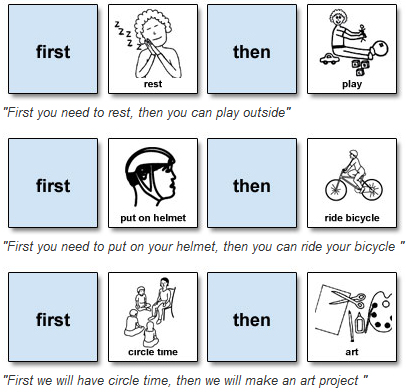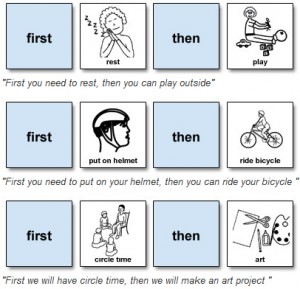
Special Education  Visual supports have proven to be a huge success with my students when helping to mainstream them into their general education classrooms. When implemented appropriately, visual supports will allow students with special needs access to the general education curriculum and will help with the inclusion process. For some students, their visuals are almost a lifeline to help them through their day.
I often laugh at my observation that many times an adult is the one who is causing the problem for a child who is having a meltdown. One day, I just could not figure out why one of my students was literally in tears heading to music class. Oops! Mrs. Ferry forgot his visual schedule! For this particular student, his visual schedule book helps him understand the rules and expectations in music class. He knows exactly what he needs to do and for a child who has such a severe language impairment and therefore can not communicate like other students, his visuals help him connect with everyone else. A brief jog back to his classroom to grab that book and he was all ready for music with a smile on his face! Whew!!
Visual supports have proven to be a huge success with my students when helping to mainstream them into their general education classrooms. When implemented appropriately, visual supports will allow students with special needs access to the general education curriculum and will help with the inclusion process. For some students, their visuals are almost a lifeline to help them through their day.
I often laugh at my observation that many times an adult is the one who is causing the problem for a child who is having a meltdown. One day, I just could not figure out why one of my students was literally in tears heading to music class. Oops! Mrs. Ferry forgot his visual schedule! For this particular student, his visual schedule book helps him understand the rules and expectations in music class. He knows exactly what he needs to do and for a child who has such a severe language impairment and therefore can not communicate like other students, his visuals help him connect with everyone else. A brief jog back to his classroom to grab that book and he was all ready for music with a smile on his face! Whew!!
 I am often shocked at the unwillingness of some teachers to implement visuals for students who could benefit from their support. But when I take a step back I realize what we all know is true: change is difficult and if we are going to put in the effort to implement something, we want results! Like anything, visuals are going to take time to TEACH.
A child will not be able to use them successfully their first day, or even their first week. But, with continued exposure and explanation, visuals will help students. And the great thing is – visuals have not only been shown to be successful for students with disabilities but with ALL students.
If you create a classroom for a student with autism, you have created a classroom for all students to thrive in. Visuals should be part of that classroom!
Researchers have determined that visual supports help create independence and are beneficial when mainstreaming a child with special needs, specifically autism (Rao and Gagie, 2006).
These authors indicated that visual supports help by:
I am often shocked at the unwillingness of some teachers to implement visuals for students who could benefit from their support. But when I take a step back I realize what we all know is true: change is difficult and if we are going to put in the effort to implement something, we want results! Like anything, visuals are going to take time to TEACH.
A child will not be able to use them successfully their first day, or even their first week. But, with continued exposure and explanation, visuals will help students. And the great thing is – visuals have not only been shown to be successful for students with disabilities but with ALL students.
If you create a classroom for a student with autism, you have created a classroom for all students to thrive in. Visuals should be part of that classroom!
Researchers have determined that visual supports help create independence and are beneficial when mainstreaming a child with special needs, specifically autism (Rao and Gagie, 2006).
These authors indicated that visual supports help by:
5 Visual Support Tools for the Special Education Classroom
 Visual supports have proven to be a huge success with my students when helping to mainstream them into their general education classrooms. When implemented appropriately, visual supports will allow students with special needs access to the general education curriculum and will help with the inclusion process. For some students, their visuals are almost a lifeline to help them through their day.
I often laugh at my observation that many times an adult is the one who is causing the problem for a child who is having a meltdown. One day, I just could not figure out why one of my students was literally in tears heading to music class. Oops! Mrs. Ferry forgot his visual schedule! For this particular student, his visual schedule book helps him understand the rules and expectations in music class. He knows exactly what he needs to do and for a child who has such a severe language impairment and therefore can not communicate like other students, his visuals help him connect with everyone else. A brief jog back to his classroom to grab that book and he was all ready for music with a smile on his face! Whew!!
Visual supports have proven to be a huge success with my students when helping to mainstream them into their general education classrooms. When implemented appropriately, visual supports will allow students with special needs access to the general education curriculum and will help with the inclusion process. For some students, their visuals are almost a lifeline to help them through their day.
I often laugh at my observation that many times an adult is the one who is causing the problem for a child who is having a meltdown. One day, I just could not figure out why one of my students was literally in tears heading to music class. Oops! Mrs. Ferry forgot his visual schedule! For this particular student, his visual schedule book helps him understand the rules and expectations in music class. He knows exactly what he needs to do and for a child who has such a severe language impairment and therefore can not communicate like other students, his visuals help him connect with everyone else. A brief jog back to his classroom to grab that book and he was all ready for music with a smile on his face! Whew!!
 I am often shocked at the unwillingness of some teachers to implement visuals for students who could benefit from their support. But when I take a step back I realize what we all know is true: change is difficult and if we are going to put in the effort to implement something, we want results! Like anything, visuals are going to take time to TEACH.
A child will not be able to use them successfully their first day, or even their first week. But, with continued exposure and explanation, visuals will help students. And the great thing is – visuals have not only been shown to be successful for students with disabilities but with ALL students.
If you create a classroom for a student with autism, you have created a classroom for all students to thrive in. Visuals should be part of that classroom!
Researchers have determined that visual supports help create independence and are beneficial when mainstreaming a child with special needs, specifically autism (Rao and Gagie, 2006).
These authors indicated that visual supports help by:
I am often shocked at the unwillingness of some teachers to implement visuals for students who could benefit from their support. But when I take a step back I realize what we all know is true: change is difficult and if we are going to put in the effort to implement something, we want results! Like anything, visuals are going to take time to TEACH.
A child will not be able to use them successfully their first day, or even their first week. But, with continued exposure and explanation, visuals will help students. And the great thing is – visuals have not only been shown to be successful for students with disabilities but with ALL students.
If you create a classroom for a student with autism, you have created a classroom for all students to thrive in. Visuals should be part of that classroom!
Researchers have determined that visual supports help create independence and are beneficial when mainstreaming a child with special needs, specifically autism (Rao and Gagie, 2006).
These authors indicated that visual supports help by:
- Allowing students to focus
- Making abstract concepts more visually concrete
- Allowing students to express their thoughts
- Bringing routine, structure, and sequence
- reducing anxiety
- serving as a tool to assist with transitions.



